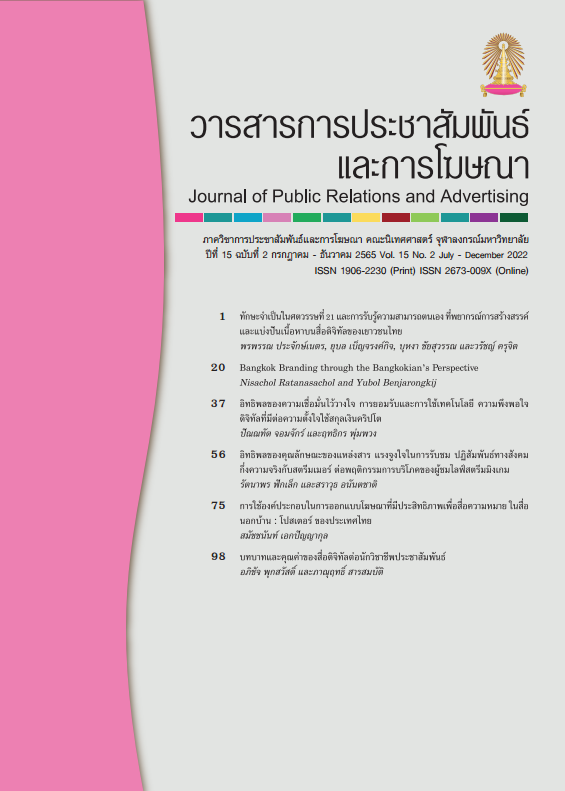ฺBangkok Branding through the Bangkokian's Perspective.
Main Article Content
Abstract
This research aims to 1) study Bangkok’s identity of the Conventional Districts through the Bangkokian’s perspective, 2) explore the development of the Conventional Districts towards the New and Emerging Districts, and 3) apply the findings of Bangkok’s identity study to Bangkok branding. The subject of this study was a 3- Helix group of policy makers, district researchers and developers, and Bangkokians. Focus-grouped interviews were conducted with the two groups: policy makers, and district researchers and developers, and a survey questionnaire was used with a group of 400 Bangkokians. The findings show that Bangkok is a multicultural society, having the Chao Phraya River and Thainess as the city’s identity. Based on the Structural Equation Model (SEM), the findings confirmed that Bangkok identity also consists of a variety of dimensions, including history and culture; natural infrastructure; and tourism and recreation, which can lead to Bangkok branding which is based on its being the capital city of history and valuable cultural heritage, its being a multicultural community with the river and canals as natural infrastructure, and its being a city with a vision towards becoming a smart city. The results, therefore, suggest the definition of Bangkok for Bangkok branding is ‘a living city of Thai heritage with natural infrastructure connecting people of multicultural and sophisticated city that keeps up with the world’.
Article Details
References
Aaker, D.A. (1996). Building strong brands. New York, NY: The Free Press.
____________,& Joachimsthaler, E. (2000). Brand Leadership. New York, NY: The Free Press.
____________ (1991). Managing Brand equity: Capitalizing on the value of a brand name. New York: Simon & Schuster Trade.
Anholt, S. (2005). Brand new justice. How branding places and products can help the developing world (2nd ed.). Oxford: Butterworth Heinemann.
__________ (2007). Competitive Identity: The new brand management for nations, cities and regions. London: Palgrave.
__________ (2009a). Places: Identity, Image and reputation. London: Palgrave.
Anholt, S. (2006). The Anholt GMI city brand index: how the world sees the world’s cities. Journal of Place Branding, 2(1), 18-31.
Boschma, R., & Fritsch, M. (2009). Creative class and regional growth: Empirical evidence from Seven European countries. Economic Geography.85(4), 391-423.
Crabtree, B.F., & Miller, W.L. (1992). Doing qualitative research: multiple strategies. Thousand Oaks, CA: Sage Publications
Dinnie K. (2008). Nation Branding: Concepts, Issues, Practice. Elsevier Ltd.
__________ (2011). City Branding: Theory and Cases. Palgrave Macmillan.
Echtner, C.M. and Ritchie, J.R.B. (2003), The meaning and measurement of destination image: (Reprint of original article published in v.2, no.2, 1991: 2-12.), Journal of Tourism Studies, 14(I), 37-48.
Geoffrey I. Crouch. (2011). Destination Competitiveness: An analysis of determinant attributes. Journal of Travel Research. 50(1), 27–45.
Gottman, J. (1995). ‘Introduction: why metropolitan organization’ in L.J. Sharpe, The Government of World Cities: The Future of the Metropolitan Model, Chichester, Wiley, 1-10.
Gronlund J. (2013). Basic of Branding: A Practical Guide for Manager. Business Expert Press, New York.
Hair, J. F., Black, W. C., Babin, B. J. & Anderson, R.E. (2010). Multivariate Data Analysis (7th ed.). Upper Saddle River, NJ: Prentice Hall.
Insch, A. (in press), “Managing residents” expectations and satisfaction with city life: Application of importance-satisfaction analysis, Journal of Town and City Management, 1(2), 164-174.
Jackson, P.A. (1998). Buddhadasa: A Buddhist Thinker for the Modern World. Bangkok Siam Society.
Keller K.L. (2013). Strategic Brand Management: Building, Measuring, and Managing Brand Equity (4th ed.) Pearson Education Limited, England.
Krit Hongjanya (2018). Nation Branding Based on Semiotic Analysis, A Case Study of Thailand Brand. Doctor of Philosophy Communication Arts and Innovation, National Institute of Development Administration.
Krit Raengsungnoen. (2011). Factor analysis with SPSS and AMOS for research. Bangkok: SE-ED Publisher
Kwuancheewa Traiphiriya (2016). The Analysis of Symbolic Meaning and the Thai Identities Construction in the Tourism Oriented Advertising Doctor of Philosophy in Communication Arts Program, Faculty of Communication. Dhurakij Pundit University.
Manasanan Potjiranukul. (2016). The Elements of Identity, Brand Image of Sukhothai Cultural Branding, and the Role in Supporting National Branding. Doctor of Philosophy in Communication Arts Faculty of Communication Arts, Dhurakij Bandit University.
Morgan N. & Pritchard A. (2011). Destination Brands Managing Place Reputation (3rd ed.). Elsevier Ltd.
Morgan, N. (2004). Problematizing Place Promotion. In A. Lew, C. M. Hall, & A. Williams (Eds), A tourism companion (pp.173-183). Oxford: Blackwell.
Naphatchanok Najpinij. (2011). Constructing “Thainess within International Food Space Thai Gastronomy in Five-Star Hotels in Bangkok. Doctor of Philosophy Program in Thai Studies Faculty of Arts Chulalongkorn University.
National Geographic Society. (2014). World’s Best Cities: Celebrating 220 Great Destination. National Geographic Society. U.S.A
Patton, M.Q. (1990). Qualitative Evaluation and Research Methods, 2nd edn. Thousand Oaks, CA: Sage.
Pride, R. (2008). The Welsh Brand – Connecting image with reality. Wales and the World Institute of Welsh Affairs Seminar, Cardiff, October.
Rao N. (2007). Cities in Transition: Growth, change and governance in six metropolitan areas. Routledge, New York, U.S.A.
Raynolds, C. J. (1991). National Identity and It’s Defenders Thailand, 1939-1989. Monash Papers on Southeast Asia- No. 25 Centre of Southeast Asian Studies, Monash University, Clayton, Vic..
Ritchie, J.R.,& Ritchie, J. B. (1998). The branding of tourism destinations. In Annual Congress of the International Association of Scientific Experts in Tourism, Morocco, September 1998.
Schumacker, R.E.,& Lomax, R.G. (2010). A Beginner guide to structural equation modeling. New York : Routledge.
The City Planning Department, Bangkok Metropolitan Administration. (2007). 225 Years of Rattanakosin. Amarin Printing. Bangkok
Urry, J. (1990). The Tourist Gaze: Leisure and Travel in Contemporary Societies. Sage, London, United Kingdom.


